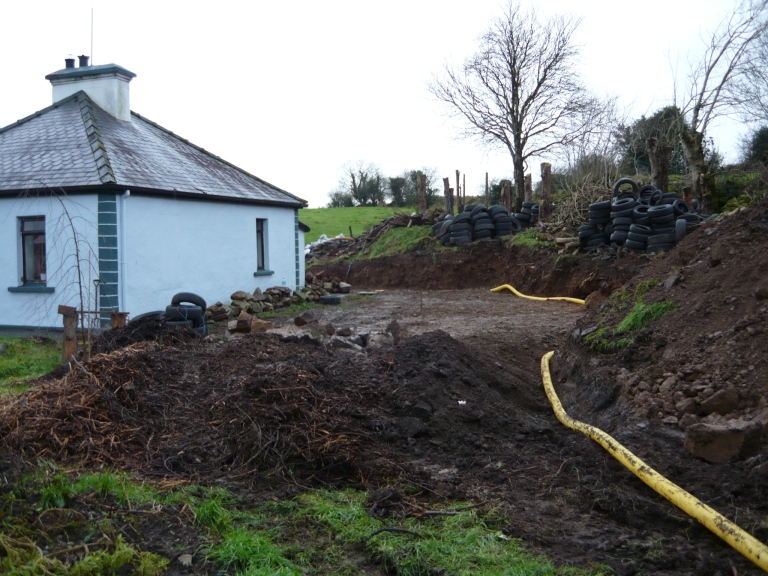We moved into our cottage in January 2013. Even before we bought it, we had decided that we would add a round house extension to it, with a reciprocal roof. These types of houses have been built for thousands of years, mainly in China and Japan. It is a very economical and environmentally sound way of building, and can be adapted to suit many climates and site conditions. We would like to share our experience of the build with our readers here, in case someone would like to embark on a similar project.

It is easy and quick to build in this way, and you can incorporate a number of recycled and found building materials. As you might know, in Irish planning law you are allowed to add a less than 40 square meter floor area extension to an existing property, as long as it meets certain criteria. We read up on the laws very thoroughly before starting our build, and if you are in anyway unsure about something, it would be a good idea to contact your local planning permission officials at this point. We were lucky in that we had the existing cottage there already, and did not need to apply for planning permission for a new build.

Our first efforts went into levelling the ground behind the house, as a slope went straight onto the corner of the house, with soil washing up against it. A friend with a digger came and gave us a hand with this part. We then dug drainage ditches by hand all around the perimeter of the new extension, filling them with drainage pipes and round gravel, wrapped in permeable plastic. The drainage ditches need to slope away from the building and onto lower ground. In our case we lead them down towards our stream running through the bottom of the garden. It would be a good idea to see the site in winter, and asses if you have put in sufficient drainage before the foundation work commences. We have very high rainfall in this part of Ireland, so sorting out the drainage was a top priority.


After we moved the soil for levelling the ground, we decided to use it to build a retaining wall around our extension. We wrote about this process last year in this post.

When our retaining tyre wall was in place it was time to start the actual building in earnest. The first step was to put in the foundations for the upright whole tree trunks, which, along with the henges, makes up the main frame of the building. We used cardboard moulds to pour the concrete into and placed a piece of rebar in the centre of each circular post support. This makes for a strong foundation, using a tiny amount of concrete compared to a more conventional building. Depending on your type of soil, you might want to dig holes as well, and fill them partially with clean gravel before pouring in your concrete mixture. This would create a deeper and stronger support for each post. Our building is set on very firm clay soil, so we did not need very deep supports. Because of the way this type of building is constructed, there is allowance for some movement in the timber frame and they have been proven to withstand earthquakes better than conventional buildings made from bricks, mortar and steel.


Adding a coin for luck.

The concrete supports covered with plastic bags to prevent them drying out to fast.
In our next part of this series, we will move onto constructing the actual framework for the building. You can find all posts concerning this build in the category, reciprocal roundhouse. And to finish this post off, here are a few photos to inspire you, of the building in its more finished stages.







Wonderful post need to get so much more info , going to be busy trying to source the tyres; first on a different note, if one was to grow veg or herbs in tyres is there anything I need to treat the tyre with in order to make it organically friendly ? . Just love your blog but will have to leave the magic it holds for me till tow. night as tomorrow is promised great sunshine hubby informed me earlier and I love to be out working with the land and enjoying the air ,intoxicating isn’t it how lovely to be filled with excitement for the dawn so grateful for this kind regards Kathy.
LikeLiked by 1 person